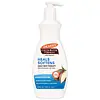What's inside
What's inside
 Key Ingredients
Key Ingredients

 Benefits
Benefits

 Concerns
Concerns

 Ingredients Side-by-side
Ingredients Side-by-side

Water
Skin ConditioningTheobroma Cacao Extract
Skin ConditioningGlyceryl Stearate
EmollientPetrolatum
EmollientPropylene Glycol
HumectantGlycerin
HumectantCocos Nucifera Oil
MaskingParaffinum Liquidum
EmollientTheobroma Cacao Seed Butter
EmollientElaeis Guineensis Oil
EmollientCetyl Alcohol
EmollientDimethicone
EmollientTocopherol
AntioxidantHelianthus Annuus Seed Oil
EmollientHydroxyethylcellulose
Emulsion StabilisingPEG-8 Stearate
EmulsifyingBehentrimonium Methosulfate
Butylene Glycol
HumectantStearalkonium Chloride
PreservativeCellulose
AbsorbentSodium Acetate
BufferingParfum
MaskingDimethyl Stearamine
EmulsifyingPhenoxyethanol
PreservativeSorbic Acid
PreservativeBenzoic Acid
MaskingStearyl Alcohol
EmollientMyristyl Alcohol
EmollientCI 19140
Cosmetic ColorantCI 15510
Cosmetic ColorantBenzyl Alcohol
PerfumingWater, Theobroma Cacao Extract, Glyceryl Stearate, Petrolatum, Propylene Glycol, Glycerin, Cocos Nucifera Oil, Paraffinum Liquidum, Theobroma Cacao Seed Butter, Elaeis Guineensis Oil, Cetyl Alcohol, Dimethicone, Tocopherol, Helianthus Annuus Seed Oil, Hydroxyethylcellulose, PEG-8 Stearate, Behentrimonium Methosulfate, Butylene Glycol, Stearalkonium Chloride, Cellulose, Sodium Acetate, Parfum, Dimethyl Stearamine, Phenoxyethanol, Sorbic Acid, Benzoic Acid, Stearyl Alcohol, Myristyl Alcohol, CI 19140, CI 15510, Benzyl Alcohol
Water
Skin ConditioningAlcohol Denat.
AntimicrobialHamamelis Virginiana Extract
AntiseborrhoeicPEG-40 Hydrogenated Castor Oil
EmulsifyingMelaleuca Alternifolia Leaf Oil
AntioxidantTocopheryl Acetate
AntioxidantSalicylic Acid
MaskingLactic Acid
BufferingSodium C14-16 Olefin Sulfonate
CleansingSodium Hydroxide
BufferingTetrasodium EDTA
Ethylhexylglycerin
Skin ConditioningPhenoxyethanol
PreservativeParfum
MaskingButylphenyl Methylpropional
PerfumingLimonene
PerfumingBenzyl Benzoate
AntimicrobialCI 42090
Cosmetic ColorantCI 14700
Cosmetic ColorantWater, Alcohol Denat., Hamamelis Virginiana Extract, PEG-40 Hydrogenated Castor Oil, Melaleuca Alternifolia Leaf Oil, Tocopheryl Acetate, Salicylic Acid, Lactic Acid, Sodium C14-16 Olefin Sulfonate, Sodium Hydroxide, Tetrasodium EDTA, Ethylhexylglycerin, Phenoxyethanol, Parfum, Butylphenyl Methylpropional, Limonene, Benzyl Benzoate, CI 42090, CI 14700
 Reviews
Reviews

Ingredients Explained
These ingredients are found in both products.
Ingredients higher up in an ingredient list are typically present in a larger amount.
Parfum is a catch-all term for an ingredient or more that is used to give a scent to products.
Also called "fragrance", this ingredient can be a blend of hundreds of chemicals or plant oils. This means every product with "fragrance" or "parfum" in the ingredients list is a different mixture.
For instance, Habanolide is a proprietary trade name for a specific aroma chemical. When used as a fragrance ingredient in cosmetics, most aroma chemicals fall under the broad labeling category of “FRAGRANCE” or “PARFUM” according to EU and US regulations.
The term 'parfum' or 'fragrance' is not regulated in many countries. In many cases, it is up to the brand to define this term.
For instance, many brands choose to label themselves as "fragrance-free" because they are not using synthetic fragrances. However, their products may still contain ingredients such as essential oils that are considered a fragrance by INCI standards.
One example is Calendula flower extract. Calendula is an essential oil that still imparts a scent or 'fragrance'.
Depending on the blend, the ingredients in the mixture can cause allergies and sensitivities on the skin. Some ingredients that are known EU allergens include linalool and citronellol.
Parfum can also be used to mask or cover an unpleasant scent.
The bottom line is: not all fragrances/parfum/ingredients are created equally. If you are worried about fragrances, we recommend taking a closer look at an ingredient. And of course, we always recommend speaking with a professional.
Learn more about ParfumPhenoxyethanol is a preservative that has germicide, antimicrobial, and aromatic properties. Studies show that phenoxyethanol can prevent microbial growth. By itself, it has a scent that is similar to that of a rose.
It's often used in formulations along with Caprylyl Glycol to preserve the shelf life of products.
Water. It's the most common cosmetic ingredient of all. You'll usually see it at the top of ingredient lists, meaning that it makes up the largest part of the product.
So why is it so popular? Water most often acts as a solvent - this means that it helps dissolve other ingredients into the formulation.
You'll also recognize water as that liquid we all need to stay alive. If you see this, drink a glass of water. Stay hydrated!
Learn more about Water